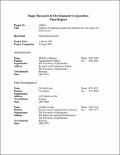| Organisation | University of Queensland (UQ) |
| Organisation | Sugar Research and Development Corporation (SRDC) |
| Author | McDonald, L |
| Date Accessioned | 2013-11-28 |
| Date Available | 2013-11-28 |
| Issued | 2001 |
| Identifier | http://hdl.handle.net/11079/12934 |
| Abstract | This project provided an in-depth re-analysis of district level data for cane yield, sugar content, and sugar content per hectare for the mill districts of Mulgrave, Babinda, and Tully and an evaluation of the estimates of changes in productivity for the period from 1958 to 1995, as derived by Leslie and Wilson (1996). Restricted Maximum Likelihood (REML) methodology (Patterson and Thompson, 1971) was shown to be applicable to the analysis of productivity data at the district level. Importantly, this methodology can now be implemented with readily available computer software (Gilmour et al., 1996). Its capacity to deal with unbalanced data sets (varieties change over time and across districts) is particularly useful. REML enables a more rigorous and complete estimation of productivity trends over time when adjusting for variety and variety environment interactions than previously used methods. For the period under investigation, some of the increased cane yield (tonnes of sugarcane per hectare) was due to improved varieties while the decrease in sugar content was due to other factors. As a result, sugar content per hectare remained relatively stable during this time. |
| Language | en |
| Part of Series | Internal Report; 2001 UQ034 |
| Subject | Restricted Maximum Likelihood (REML) methodology |
| Subject | Productivity data |
| Subject | Variety evaluation |
| Subject | Productivity changes |
| Subject | Cane yield (TCH) analysis |
| Subject | Sugar content (CCS) analysis |
| Subject | ASREML |
| Subject | Best linear unbiased predictors (BLUPs) |
| Subject | Best linear unbiased estimates (BLUEs) |
| Subject | Quantitative genetics |
| Subject | Plant genetics |
| Subject | Varieties |
| Subject | Plant breeding |
| Title | Analysis of sugarcane productivity trends in the wet tropics at a district level : SRDC final report |

